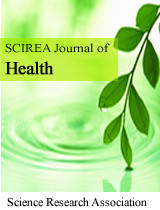Trends in Prevalence of Hipercholesterolemia Among Catalan Adults 2001-2018 (Osona–Barcelona)
DOI: 10.54647/pmh33222 98 Downloads 112020 Views
Author(s)
Abstract
Background: The total cholesterol values of the Spanish population are high. The Preventive Activities Programs developed are not being sufficiently effective in improving population cholesterolemia. The involvement of other elements of society (education, the media, the food industry, etc.) may be essential in controlling the population's cholesterol.
Aim: To compare the evolution of serum concentrations of total cholesterol in a population between the years 2001, 2006 and 2018.
Design and setting: Cross-sectional study comparing the evolution of serum total cholesterol concentrations in a population between the years 2001-2018. It has been carried out on patients who have been visited in health centers in the Osona county (Barcelona, NE Spain).
Methods: Cross-sectional observational study. Total serum cholesterol (TC) values of patients studied between September and December 2001 were compared with patients analyzed during the same period of 2006 and 2018.
Results: The values of the population cholesterol means, according to sex and age strata in 2018 are lower than those of the previous periods (2001 and 2006).
The average decrease in cholesterol concentration between 2001 and 2018 is 10mg / dL for women (corresponding to a 5% reduction) and 17mg / dL for men (8% reduction).
Discussion and conclusions: The causes of this trend towards a decrease in the total cholesterol level can be explained in a multifactorial way: interventions in all healthcare settings, self-awareness of the health problem and preventive population campaigns on this issue.
In conclusion, in recent years there has been a marked reduction in the average level of total cholesterol in Osona county population. However, hypercholesterolemia still remains a highly prevalent cardiovascular risk factor, accounting for 48% of the population studied in 2018.
Keywords
Population cholesterol, Primary care, Prevention, Cardiovascular disease
Cite this paper
Joan Deniel-Rosanas, Jordi Prat-Quinzaños, Pere Roura-Poch, Maria-Àngels Casas-Capdevila, Victor Farré-Guerrero,
Trends in Prevalence of Hipercholesterolemia Among Catalan Adults 2001-2018 (Osona–Barcelona)
, SCIREA Journal of Health.
Volume 6, Issue 4, August 2022 | PP. 52-64.
10.54647/pmh33222
References
| [ 1 ] | Grau M, Subirana I, Elosua R, et al. Trends in cardiovascular risk factor prevalence (1995-2000-2005) in northeastern Spain. Eur J Cardiovasc Prev Rehabil 2007; 14 (5): 653-9. Errata in Eur J Cardiovasc Prev Rehabil 2008; 15(4): 502.https://doi.org/10.1097/HJR.0b013e3281764429 |
| [ 2 ] | Grau M, Elosua R, Cabrera de León A, et al. Factores de riesgo cardiovascular en España en la primera década del siglo XXI: Análisis agrupado con datos individuales de 11 estudios de base poblacional, estudio DARIOS. Rev Esp Cardiol 2011; 64 (4): 295-304.https://doi.org/10.1016/j.recesp.2010.11.005 |
| [ 3 ] | Guallar-Castillón P, Gil-Montero M, León-Muñoz LM, et al. Magnitud y manejo de la hipercolesterolemia en la población adulta de España, 2008-2010: El estudio ENRICA. Rev Esp Cardiol 2012; 65 (6): 551-8.https://doi.org/10.1016/j.recesp.2012.02.005 |
| [ 4 ] | Deniel-Rosanas J, Prat-Quinzaños J, Roura-Poch P, et al. Evolución 2001-2018 de los niveles de colesterol sérico en una población de Cataluña (Osona, Barcelona). Atención Primaria Práctica 2021; 3: 100080. http://dx.doi.org/10.1016/j.appr.2020.100080 4 |
| [ 5 ] | Patel N, Bhargava A, Kalra R, et al. Trends in lipid, lipoproteins, and statin use among US adults. Impact of 2013 cholesterol guidelines. J Am Coll Cardiol 2019; 74(20): 2525-8. http://dx.doi.org/10.1016/j.jacc.2019.09.026 5 |
| [ 6 ] | Carroll MD, Kit BK, Lacher DA, et al. S.T. Shero, M.E. Mussolino. Trends in lipids and lipoproteins in US adults, 1988-2010. JAMA 2012; 308(15): 1545-54. http://dx.doi.org/10.1001/jama.2012.13260 |
| [ 7 ] | Ferrières J, Bongard V, Dallongeville J, et al. Trends in plasma lipids, lipoproteins and dyslipidemias in French adults, 1996-2007. Arch Cardiovasc Dis 2009; 102(4): 293-301. http://dx.doi.org/10.1016/j.acvd.2009.02.002 |
| [ 8 ] | Farzadfar F, Finucane MM, Danaei G, et al. National, regional, and global trends in serum total cholesterol since 1980: Systematic analysis of health examination surveys and epidemiological studies with 321 country-years and 3.0 million participants. Lancet 2011; 377: 578-86.http://dx.doi.org/10.1016/S0140-6736(10)62038-7 |

